For 17th century ships, it's not sometimes, it's most of the time.I understand, but sometimes, history doesn't give us any evidence as to how to present this or that part of the ship on the model, and we use any documentation (including the contemporary models) as a reference to present the model as historically accurate.
-

Win a Free Custom Engraved Brass Coin!!!
As a way to introduce our brass coins to the community, we will raffle off a free coin during the month of August. Follow link ABOVE for instructions for entering.
You are using an out of date browser. It may not display this or other websites correctly.
You should upgrade or use an alternative browser.
You should upgrade or use an alternative browser.
Beginner's mistake: the waterline will be wrong!! I'll do some calculations and get back to you so you can correct your mistake.!!So this isn't historically accurate, well I never would have thought that, sorry I couldn't resist,
View attachment 450487
View attachment 450488
View attachment 450489
best regards John,
For me it is the fun of making stuff. It doesn’t need to be 100% historical right. I think this forum is thriving because members helping people with how to make things and showing a logic in the way they has been built in the past. Unfortunately there more and more posts about who is “real modeller” and yours amount of rivets is wrong. I have been a member of few such a forum that died because has been taken over by “rivet counters” and “accuracy specialists “. Which was very difficult to find their own work by the way. So let’s build in the way make us happy and show the work so others can improve their technique and way of making stuff.
Live is too short for rivet counting
Live is too short for rivet counting
I totally agree that finding full sets of contemporary plans is nigh impossible for the 17th century. Fortunately we do have contemporary models as you pointed out. Of possibly as much importance for scantlings and such are contemporary contracts. The National Archives in Kew and RMG Collections has many such contracts. Reading these old hand written documents is a challenge that is fun at times and frustrating at other times. The NA does have a tutorial of sorts on paleography which is a big help. The contracts are not to be shared as photographed but transcribed contracts can be shared. A small sample of the original from 1693 and most of the first page of the transcription I did is below.For 17th century ships, it's not sometimes, it's most of the time
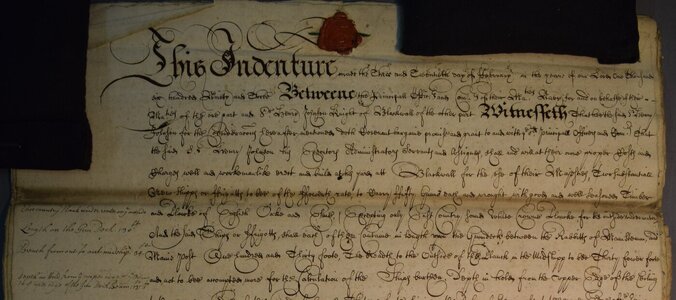
Spelling below is as found in the contract above
This Indenture made the three and eighth day of February in the Year of our Lord One Thousand Six Hundred and Ninety and three Between the Principall Officers and Commissioners of their Majesty’s Navy For and on behalf of their Majesty of the One Part and Sir Henry Johnson Knight of Blackwall of the other Part Witnesseth that he the Said Sir Henry Johnson for the Considerations hereafter Mentioned doth Covenant bargaine Promise & Grant to & with the Said Principall Officers & Commissioners That the Said Sir Henry Johnson his Executors Administrators Servants & Assigns Shall & will at their own Proper Costs & Charges well and Workmanlike Erect & Build at his Yard at Blackwall for the Use of their Majesty Two Substantiall New Ships or Friggotts to be of the Fourth Rate and to Carry Fifty Guns each and Wrought with Good & Well Seasoned Timber Planck of English Oak & Elm (excepting only East Country Sound White Crowne Planck for the Outside Under water) and the said ships or friggotts shall Each of them Containe in Length upon the Gundeck between the Rabbitts of Maine Stem and Maine Post One Hundred & thirty foot. The Breadth to the Outside of the Planck in the Midshipp to be Thirty Four Foot and not to be Accompted More for the Calculation of the Ships Burthen. Depth in Hold from the Upper Edge of the Ceiling to the Upper Edge of the Gundeck Beams Thirteen Foot Six Inches, The Rake of Sterne Post to the Upper Edge of the Wing Transom to be Four Foot Six Inches XXX and the Rake forward to the Lower Harpings to be Left to the Discretion of the Builder Saving that it shall not Exceed the Proportion of Three Fifth Parts of the Maine Breadth Nor be less than Halfe thereof and the Length of the Keele for Computation of the Ships Burthen shall be Accompted One Hundred and Nine Foot and not More. The Length of the Maine Transome To be Twenty foot within the Planck The Heigth between Decks at the Sides in the Midships to be Six Foot Two Inches and of a Proportionable Heigth in all other Places. And the Depth of the Wast from the Deck to the Upper Edge of the Planshire To be Four Foot Five Inches And the Scantlings, Scarphings, Bolts, Fastenings, workmanship, Compleat and Entire Finishing of the Hulls or Bodyes of the Said Two Ships Shall be as Followeth (Vizt)
The Keeles to be of Elm (not more than three peeces) and to be fourteen inches square in the Midships with Scarphs Four Foot Four Inches Long at least and Each Scarph Tabled and laid with Tarr & Hair, to be well bolted with Six Bolts by an Inch Auger and the False Keeles To be Three Inches thick of Elme laid with Tarr & Hair and well fastened with Treenails Spikes and Staples.
Stemmes To be of good Sound Oak Timber Thirteen Inches Thwartships, & Fifteen Inches fore & aft, The Scarphe not to be less than Four Foot Bolted with Six Bolts by an Inch Auger.
False Stems To be Twenty Two Inches Broad and Eight Inches Thick and One Foot at least in the Scarph Well Bolted with Inch Bolts into the Stem.
The Sterne Posts To be Sixteen Inches Thwart and Eighteen Inches Fore & aft in the Head, and Two Foot Fore and aft Upon the Keele. the false posts within the sterne post to be Fifteen Inches fore and aft and Eighteen Inches thwartships, and to bring upon each keel two substantiall Pieces of Rising Wood of sufficient length for the Run of the Ships and then to bring on a well growne Substantiall Knee upon the same fayed to the Sterne Post.
Last edited:
- Joined
- Dec 1, 2016
- Messages
- 6,334
- Points
- 728

We are going in circles, Dave. Does the modeler have to know the difference? What is the intent of the modeler to build models? Does he/she want to present a historically accurate model or does he just want to build something for fun?
But what is wrong with building your model from another model? Sometimes the contemporary model is the only source of information to build. How can you go about historically accurate representation in such cases?
Novices rarely build the model from scratch, unless it is a skilled individual with previous experience in woodworking and metalsmithing. They most likely will use a kit. Can you build an authentically correct model from the kit without bashing?
BTW, what is authentically correct? Is there such a term?
historically accurate was not my point in using another model as a reference.
for example you have a builder struggling with planking a hull and looking through build logs or the gallery of finished models to see how other builders planked a hull.
maybe a novice builder did not know you have to bevel the edges of the bulkheads and ends up with this, a hard edge. There is no garboard on this model so how does a novice know he has to shape a garboard when using this as an example.
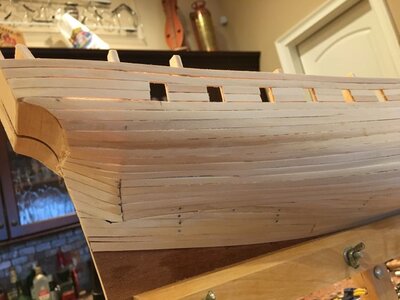
a hard edge because filler blocks were not used, and the planking is lying flat between bulkheads and the planking is not running to the stem.
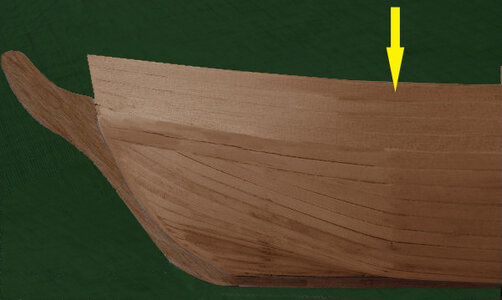
is this a proper example of planking a hull? how would a first time builder know if it is right or wrong? if it it posted "nice job"
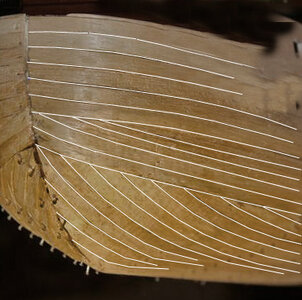
you know this is not going to work out there is far too much open space midship and nothing at the bow
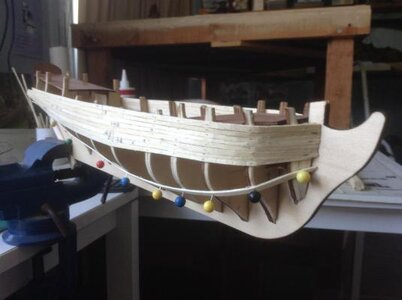
so you end up with this

looks like this builder had no idea how to fit a garboard plank and if there are models that are planked wrong a novice will struggle by looking at these examples.
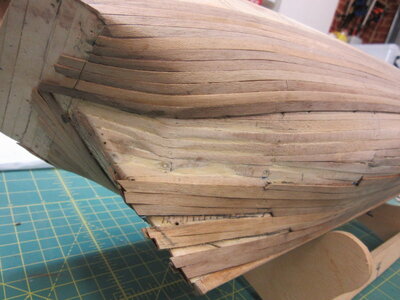
at the bow one example is wrong and one is right
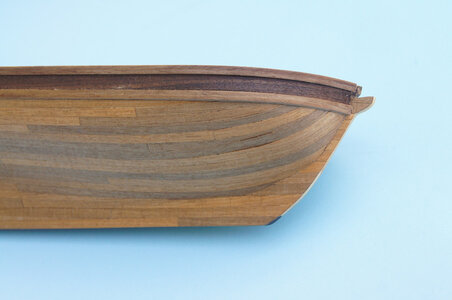
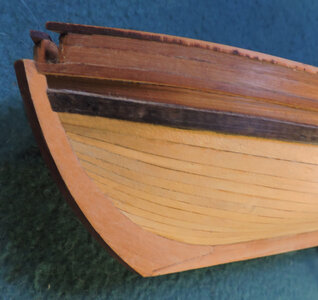
you can tell a builder heck do it your way and whatever you do just get planks on the hull it does not matter just struggle with it until the hull is planked.
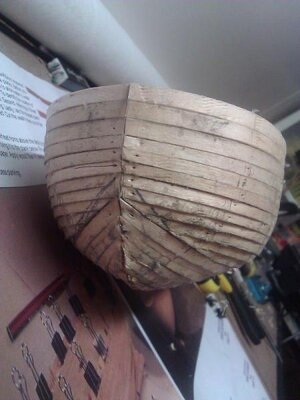
so my point is there are rules and methods for building and if you know the rules and methods the job becomes easier rather than struggling with examples of what not to do. Maybe it is better in the long run to use a model as a reference built by someone who actually knows what they are doing. Using examples that are wrong is a blind novice leading the blind.
Historical accuracy has nothing to do with proper building methods and taking the struggle out of the build
so back to the original do this and not that or point out to a builder what is going wrong and what will happen if you continue doing it your way rather than the right way. I understand builders just having fun building something but that is not the point, the point is calling an error an error on forums used by others.
But what is wrong with building your model from another model? Sometimes the contemporary model is the only source of information to build. How can you go about historically accurate representation in such cases?
Novices rarely build the model from scratch, unless it is a skilled individual with previous experience in woodworking and metalsmithing. They most likely will use a kit. Can you build an authentically correct model from the kit without bashing?
BTW, what is authentically correct? Is there such a term?
historically accurate was not my point in using another model as a reference.
for example you have a builder struggling with planking a hull and looking through build logs or the gallery of finished models to see how other builders planked a hull.
maybe a novice builder did not know you have to bevel the edges of the bulkheads and ends up with this, a hard edge. There is no garboard on this model so how does a novice know he has to shape a garboard when using this as an example.

a hard edge because filler blocks were not used, and the planking is lying flat between bulkheads and the planking is not running to the stem.

is this a proper example of planking a hull? how would a first time builder know if it is right or wrong? if it it posted "nice job"

you know this is not going to work out there is far too much open space midship and nothing at the bow

so you end up with this

looks like this builder had no idea how to fit a garboard plank and if there are models that are planked wrong a novice will struggle by looking at these examples.

at the bow one example is wrong and one is right


you can tell a builder heck do it your way and whatever you do just get planks on the hull it does not matter just struggle with it until the hull is planked.

so my point is there are rules and methods for building and if you know the rules and methods the job becomes easier rather than struggling with examples of what not to do. Maybe it is better in the long run to use a model as a reference built by someone who actually knows what they are doing. Using examples that are wrong is a blind novice leading the blind.
Historical accuracy has nothing to do with proper building methods and taking the struggle out of the build
so back to the original do this and not that or point out to a builder what is going wrong and what will happen if you continue doing it your way rather than the right way. I understand builders just having fun building something but that is not the point, the point is calling an error an error on forums used by others.
I think the initial post was about to pointing out the historical inaccuracies, like stuff should be there or wrong count of rivet. I’m here to learn how to do stuff better and in the end properly. I think we need to encourage novices to stay in the hobby. One of the way is saying “good job”. And you welcome to follow it with :”but….” I think everyone will appreciated good advice backed up with pictures and etc. We all would be ok to receive some harsh stick if there is a carrot on the other end
- Joined
- Oct 9, 2020
- Messages
- 2,191
- Points
- 488

some of those photos make me cringe.We are going in circles, Dave. Does the modeler have to know the difference? What is the intent of the modeler to build models? Does he/she want to present a historically accurate model or does he just want to build something for fun?
But what is wrong with building your model from another model? Sometimes the contemporary model is the only source of information to build. How can you go about historically accurate representation in such cases?
Novices rarely build the model from scratch, unless it is a skilled individual with previous experience in woodworking and metalsmithing. They most likely will use a kit. Can you build an authentically correct model from the kit without bashing?
BTW, what is authentically correct? Is there such a term?
historically accurate was not my point in using another model as a reference.
for example you have a builder struggling with planking a hull and looking through build logs or the gallery of finished models to see how other builders planked a hull.
maybe a novice builder did not know you have to bevel the edges of the bulkheads and ends up with this, a hard edge. There is no garboard on this model so how does a novice know he has to shape a garboard when using this as an example.
View attachment 450570
a hard edge because filler blocks were not used, and the planking is lying flat between bulkheads and the planking is not running to the stem.
View attachment 450571
is this a proper example of planking a hull? how would a first time builder know if it is right or wrong? if it it posted "nice job"
View attachment 450572
you know this is not going to work out there is far too much open space midship and nothing at the bow
View attachment 450573
so you end up with this
View attachment 450574
looks like this builder had no idea how to fit a garboard plank and if there are models that are planked wrong a novice will struggle by looking at these examples.
View attachment 450575
at the bow one example is wrong and one is right
View attachment 450576
View attachment 450577
you can tell a builder heck do it your way and whatever you do just get planks on the hull it does not matter just struggle with it until the hull is planked.
View attachment 450578
so my point is there are rules and methods for building and if you know the rules and methods the job becomes easier rather than struggling with examples of what not to do. Maybe it is better in the long run to use a model as a reference built by someone who actually knows what they are doing. Using examples that are wrong is a blind novice leading the blind.
Historical accuracy has nothing to do with proper building methods and taking the struggle out of the build
so back to the original do this and not that or point out to a builder what is going wrong and what will happen if you continue doing it your way rather than the right way. I understand builders just having fun building something but that is not the point, the point is calling an error an error on forums used by others.
- Joined
- Dec 1, 2016
- Messages
- 6,334
- Points
- 728

Dragdonius
I think the initial post was about to pointing out the historical inaccuracies, like stuff should be there or wrong count of rivet. I’m here to learn how to do stuff better and in the end properly. I think we need to encourage novices to stay in the hobby. One of the way is saying “good job”. And you welcome to follow it with :”but….” I think everyone will appreciated good advice backed up with pictures and etc. We all would be ok to receive some harsh stick if there is a carrot on the other end
original comment
Being still somewhat new to this web site, can someone give me some advice as to how react to a modeler's post showing obvious inaccuracies, historic, construction, equipment, ect., in either or both the progress of the build or in the finished product?
the original post was pointing out obvious inaccuracies historic as well as construction. etc. which are posted in a public forum and not models in a private setting as said in private setting in your house anything goes.
so should it be pointed out the planking process is wrong or just let it go, how do you pass on information to beginners if everything is acceptable?
example my daughter is a grade school teacher let's just say she personally believes the earth is flat and brings this image to class and tells her students the earth is flat. Her young grade school students go home thinking the earth is flat because their teacher said so.
is this acceptable?
you post a bad planking job and posted under it is good job or nice work and beginners do not know the difference between right planking or wrong planking.
is this acceptable?
we are not talking what is done in private or models in private hands that no one sees we are talking what is presented in the public eye.

I think the initial post was about to pointing out the historical inaccuracies, like stuff should be there or wrong count of rivet. I’m here to learn how to do stuff better and in the end properly. I think we need to encourage novices to stay in the hobby. One of the way is saying “good job”. And you welcome to follow it with :”but….” I think everyone will appreciated good advice backed up with pictures and etc. We all would be ok to receive some harsh stick if there is a carrot on the other end
original comment
Being still somewhat new to this web site, can someone give me some advice as to how react to a modeler's post showing obvious inaccuracies, historic, construction, equipment, ect., in either or both the progress of the build or in the finished product?
the original post was pointing out obvious inaccuracies historic as well as construction. etc. which are posted in a public forum and not models in a private setting as said in private setting in your house anything goes.
so should it be pointed out the planking process is wrong or just let it go, how do you pass on information to beginners if everything is acceptable?
example my daughter is a grade school teacher let's just say she personally believes the earth is flat and brings this image to class and tells her students the earth is flat. Her young grade school students go home thinking the earth is flat because their teacher said so.
is this acceptable?
you post a bad planking job and posted under it is good job or nice work and beginners do not know the difference between right planking or wrong planking.
is this acceptable?
we are not talking what is done in private or models in private hands that no one sees we are talking what is presented in the public eye.

- Joined
- Mar 1, 2022
- Messages
- 655
- Points
- 308

Admiralty Board indeed approved minor alterations to 1745 establishment... . LOL
This comment and post #28 by you are perhaps the most well phrased posts I have ever seen on the subject of pointing out mistakes (inaccuracies) including how to and how not to plank a hull. They made my day! Thanksso my point is there are rules and methods for building and if you know the rules and methods the job becomes easier rather than struggling with examples of what not to do. Maybe it is better in the long run to use a model as a reference built by someone who actually knows what they are doing. Using examples that are wrong is a blind novice leading the blind.
I think that the first lines of Dave Stevens in post 30 is good, but post 28 is really bad.
There has been several posts trying to explain to Dave S why its bad to correct people that not asking for correction.
I know that many people take critic personally and if mistakes in building logs shall be corrected, many would not dare to show their building.
There has been several posts trying to explain to Dave S why its bad to correct people that not asking for correction.
I know that many people take critic personally and if mistakes in building logs shall be corrected, many would not dare to show their building.
Actually that is one of the reasons many never start a build log!I know that many people take critic personally and if mistakes in building logs shall be corrected, many would not dare to show their building.
So what you're talking about is model making technique, not historically accurate features on the model.We are going in circles, Dave. Does the modeler have to know the difference? What is the intent of the modeler to build models? Does he/she want to present a historically accurate model or does he just want to build something for fun?
But what is wrong with building your model from another model? Sometimes the contemporary model is the only source of information to build. How can you go about historically accurate representation in such cases?
Novices rarely build the model from scratch, unless it is a skilled individual with previous experience in woodworking and metalsmithing. They most likely will use a kit. Can you build an authentically correct model from the kit without bashing?
BTW, what is authentically correct? Is there such a term?
historically accurate was not my point in using another model as a reference.
for example you have a builder struggling with planking a hull and looking through build logs or the gallery of finished models to see how other builders planked a hull.
maybe a novice builder did not know you have to bevel the edges of the bulkheads and ends up with this, a hard edge. There is no garboard on this model so how does a novice know he has to shape a garboard when using this as an example.
View attachment 450570
a hard edge because filler blocks were not used, and the planking is lying flat between bulkheads and the planking is not running to the stem.
View attachment 450571
is this a proper example of planking a hull? how would a first time builder know if it is right or wrong? if it it posted "nice job"
View attachment 450572
you know this is not going to work out there is far too much open space midship and nothing at the bow
View attachment 450573
so you end up with this
View attachment 450574
looks like this builder had no idea how to fit a garboard plank and if there are models that are planked wrong a novice will struggle by looking at these examples.
View attachment 450575
at the bow one example is wrong and one is right
View attachment 450576
View attachment 450577
you can tell a builder heck do it your way and whatever you do just get planks on the hull it does not matter just struggle with it until the hull is planked.
View attachment 450578
so my point is there are rules and methods for building and if you know the rules and methods the job becomes easier rather than struggling with examples of what not to do. Maybe it is better in the long run to use a model as a reference built by someone who actually knows what they are doing. Using examples that are wrong is a blind novice leading the blind.
Historical accuracy has nothing to do with proper building methods and taking the struggle out of the build
so back to the original do this and not that or point out to a builder what is going wrong and what will happen if you continue doing it your way rather than the right way. I understand builders just having fun building something but that is not the point, the point is calling an error an error on forums used by others.
Aren't they both the same?I agree with John Hendrix. You could first ask the builder if he was intending the model to be an artist's piece or an accurate simulation of the actual ship. He may not care about accuracy, and build simply for the enjoyment of building. I am on the other end of the spectrum from John, since even though I love the building process, my goal is to try to build the most accurate model as far as available knowledge on the vessel allows. That adds a lot of research work into a model project, and expense in the form of books, but the research can also be fun, the thrill of chasing down and locating that one source which tells you the paint colors of a vessel at a certain time in its history or how the belaying points were, say belaying pins, ties to rails, kevels or cleats. Research is about 80% of the work, and most of the features of the model are educated guesses, with wild guesses being more plentiful the farther you go back in time period. The point is, what is the modeler's motivation(s) for making the model? They may be radically different than yours would be, and that is why the model looks unappealing to you. Depending on how well you know the modeler, you may be able to offer advice if he/she is trying to go for realism and falling short of the mark, but if he/she is not of the same mind as you are, just compliment him/her on the work. I do like seeking the advice of those who have the same perspective as myself for modeling, because I value greatly their criticism because it helps me become a better model maker.
Does he like this,
View attachment 450467
or this?
View attachment 450469
Both are great works of art. . .
And that, Zoly, is a continuing problem for this forum. SO MANY modeler think themselves below the standards of construction of the more experienced ones here that they absolutely refuse to post any pictures of their work. They won't benefit of any useful comments that would be helpful specific to the model they are building. It's a loss for them. Those builders willing to post pictures which they know have skill-related problems and/or are asking for advice on a feature or method gain the most, and learn the fastest.Actually that is one of the reasons many never start a build log!
Last edited:
I used to build Uber detailed 1/700 and 1/350 plastic and resin ships for competition. My ships were researched down to the dates that had certain features or did not. Many many details added that were not in the kit many details scrarchbuilt. That’s one way to build. Others would say I’m a rivet counter and they just build for fun so who cares about accuracy. There’s two sides. Do it the way you want to but your work won’t be taken seriously by skilled accurate modelers if it’s poor but a considerate builder will certainly help you learn how to do great work. Then there’s the “ I build for myself” comment, doesn’t matter what others think. Yes we all build for ourselves but showing your work and following others work is how we learn. If you want to do high quality work learn from those whose work you admire. In the end what others do let them deal with.
Some truly want to learn and are capable others either don’t really want to learn or aren’t capable of doing better. There are those who don’t have the skill or patience to do it. It’s that simple and it’s all fine.And that, Zoly, is a continuing problem for this forum. SO MANY modeler think themselves below the standards of construction of the more experienced ones here that they absolutely refuse to post any pictures of their work. They won't benefit of any useful comments that would be helpful specific to the model they are building. It's a loss for them. Those builders willing to post pictures which they know have skill-related problems and/or are asking for advice on a feature or method gain the most, and learn the fastest.
True, but if they are interested enough to build any of these models, they are quite capable of improving their skills, some easier than others, but there can be improvement if there is desire.Some truly want to learn and are capable others either don’t really want to learn or aren’t capable of doing better. There are those who don’t have the skill or patience to do it. It’s that simple and it’s all fine.
Of course but the desire isn’t there sometimes. They think it is but it’s not. Not many people have it or the dedication and time it takes to persevere for many months or even a few years to get to the goal.





